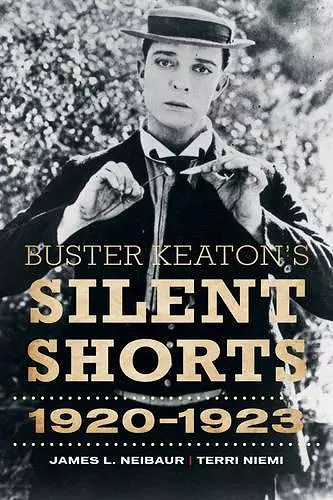Buster Keaton's Silent Shorts
1920-1923
James L Neibaur author Terri Niemi author
Format:Hardback
Publisher:Scarecrow Press
Published:30th Jan '13
Currently unavailable, and unfortunately no date known when it will be back

By the mid-1920s, Buster Keaton had established himself as one of the geniuses of cinema with such films as Sherlock, Jr., The Navigator, and his 1927 work The General, which was the highest ranked silent on the American Film Institute's survey of the 100 greatest films. Before Keaton ventured into longer works, however, he had honed his skills as an actor, writer, and director of short films produced in the early 1920s. In Buster Keaton’s Silent Shorts: 1920-1923, James L. Neibaur and Terri Niemi provide a film-by-film assessment of these brilliant two-reelers. The authors discuss the significance of each short—The High Sign, One Week, Convict 13, The Scarecrow, Neighbors, The Haunted House, Hard Luck, The Goat, The Playhouse, The Boat, The Paleface, Cops, My Wife’s Relations, The Blacksmith, Frozen North, Daydreams, The Electric House, The Balloonatic, and The Love Nest—to the Keaton filmography, as well as each film’s importance to cinema. Offering a clear and in-depth perspective on these 19 films, the authors explain what makes these shorts effective and why they’re funny. Buster Keaton’s Silent Shorts will enlighten both scholars and casual fans alike about the early work produced by one of cinema's most gifted comedians and filmmakers.
Early film icon Buster Keaton, with masterpieces such as Sherlock, Jr. and The General, ranks alongside Charlie Chaplin and Harold Lloyd in the pantheon of silent film comic geniuses. It is these feature-length films that get most of the attention from film scholars and film students alike, while his short films—in which he learned and honed his craft—tend to be largely overlooked. In their film-by-film assessment of Keaton’s short films between the years 1920 and 1923, authors Neibaur (The Silent Films of Harry Langdon: 1923–1928) and Niemi (Neibaur’s researcher on previous books) take readers through Keaton’s burgeoning film career with a delightful mix of insight, history, criticism, and a witty writing style. Verdict: This isn’t the average scholarly exploration on a very narrow topic that few will be interested in; instead, it peels back the decades and brings a fresh perspective to the often underexplored films of one of cinema’s great masters. This book will find readers across academia and the general public, which is an accomplishment indeed. * Library Journal *
As well as books about the silent films of Charlie Chaplin and Harry Langdon, the film historian, James L. Neibaur, has written an earlier book about Buster Keaton (1895-1966), The Fall on Buster Keaton (Scarecrow, 2010), which deals with Keaton's career in talking pictures. Even before he carved out an important place in silent film history with such full-length classics as The General (1926) and Steamboat Bill, Jr. (1928), Keaton starred in 19 two-reelers released between 1920 and 1923. Beginning with The High Sign (1920) and continuing with such titles as One Week (1920), The Haunted House (1921), The Playhouse (1921), and The Frozen North (1922), the series ends with The Love Nest (1923). This volume describes thoroughly each of these films with a detailed (practically frame-by-frame) plot summary plus an evaluative analysis of the film, material on film techniques utilized, and reasons for the film's importance. Background information on production details, audience reception, and a present-day evaluation of the film are also included. The material on each film is preceded by a brief table of basic information like releasing company, film credits (e.g., producers, cinematographers), and a cast list. Coverage for each film averages 10 pages. Throughout the text there are many black-and-white stills from the films and reproductions of movie posters. The book's introduction and epilogue briefly cover Keaton's career before and after the making of these short films. There is also a brief bibliography (although where the author found the wealth of material for this book is not divulged) and a four-page index (mostly names of cast members). This is a fascinating book that covers a little-known segment of film industry. One wishes that a DVD of these films could have been included with the book. This work is recommended for large media collections. * American Reference Books Annual *
The authors are precise and sharp . . . taking the films and analyzing the complexity and creativity of the stunts. The purpose is not a biography per se; however, a biography emerges from the films, which the authors masterfully unearth—through his work we find the artist. The uniqueness of Keaton is celebrated; his wry and pessimistic comedy is a wonder, an interest that Neibaur and Niemi share as they execute a balanced account of Keaton's important nineteen short films. * Film Matters *
- Winner of Huffington Post Best Film Books of 2013.
ISBN: 9780810887404
Dimensions: 235mm x 160mm x 26mm
Weight: 549g
272 pages